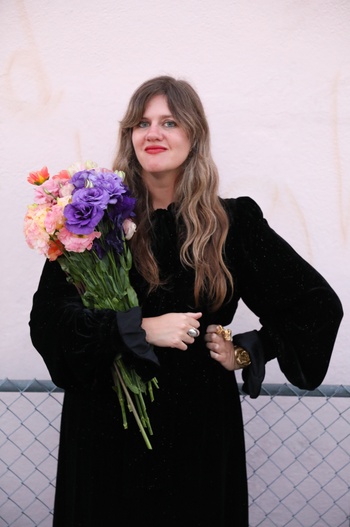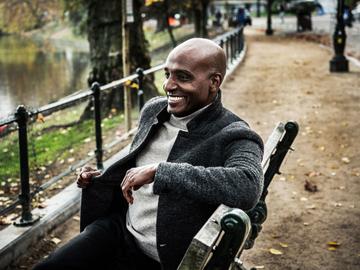Bozar closes its Opening Week with the mesmerizing Mary Lattimore, the US musician who stripped the harp of its lofty, classical image. “My goal is to make it feel more personal and less precious.”
©
jamie kelter davis
“An enormous 88 pound sculpture,” Mary Lattimore calls the overgrown, 47-stringed instrument that she carries with her to concert halls and festivals around the world, and thus also to Bozar. “You adapt your life to having this, um, this thing that you love,” the affable musician tells us with a smile over Zoom from her home in Echo Park, the hilly, hip neighbourhood in the east-central region of Los Angeles.
“I use a trolley, I make sure that I don't live in an apartment that has a lot of stairs, I have a minivan...” Lattimore makes things even easier for herself when she comes over to Europe: she keeps a second harp in a climate-controlled storage room in Brussels. “It was expensive to do that at the time, but it's a good investment,” she says. “I had just won a fellowship, and I decided to use the prize money to buy an extra instrument.”
For a lot of people, the harp seems something very delicate, untouchable almost. They think they can't get too close, because they are scared they might damage it
The harp is one of the oldest instruments in the world. You don't need much imagination to see how our distant ancestors once discovered that they could not only hunt cave bears and woolly rhinos with their bows, but also produce sound. Throughout the history of music, the harp has always had this somewhat elevated, solemn image, even though jazz musicians such as Alice Coltrane and Dorothy Ashby, and more recently folk artists like Joanna Newsom, among others, have changed that image considerably.
Recently, a remarkable number of female musicians have embraced the instrument, which initially required substantial male arms to be played and carried, although Lattimore does not want to go along with that. The American musician belongs to a new generation of harpists, including Dutchman Remy van Kesteren, who freed the instrument from its classical conventions and brought it into the 21st century. Lattimore mixes harp sounds with electronics, loops, delays and what not, lending her harp sounds to noise god Thurston Moore, indie beacons Kurt Vile and Sharon Van Etten, and musicians from The Cure and Slowdive, among others. Her most recent album, Rain on the Road, is a collaboration with American accordionist and multi-instrumentalist Walt McClements.
“For a lot of people, the harp seems something very delicate, untouchable almost,” Lattimore says. “They think they can't get too close, because they are scared they might damage it. The harp is often regarded as a museum piece, my goal is to make it feel more personal and less precious.” After her shows, Lattimore sometimes invites people to play the instrument. “They see me playing really fast and a lot of notes, but you could play just five strings and that would sound magical. There's beauty in the simplicity too.”

©
Rachel Pony Cassells
| Harpist Mary Lattimore in full bloom: "At a time when the world seems very cruel, who doesn't want to be enveloped by something warm and friendly or fly away on a giant bird?"
With a mother who also is a harpist, the harp seemed inevitable for Lattimore. Little Mary started playing the instrument when she was 11. Initially somewhat against her will. “It took until I was 16 or 17, when I learned how to play Debussy and Ravel, to really embrace the instrument,” she says. Didn't she just want to rebel with a dose of punk and rock and roll as an adolescent? “I was rebellious in different ways. (Laughs) I didn't listen to a lot of harp music, I loved rock 'n' roll. For a long time, I kept those worlds apart, until my listening and my playing merged together in my mid-twenties.”
Lattimore grew up in North Carolina and spent a few years living in Philadelphia. That she eventually moved to California has partly to do with her instrument. “In the Northeast there's a lot of snow and the ice, moving a harp and getting to gigs is not easy. I couldn't see a future in which I would have to deal with that every winter. Apart from that, I just love sunshine. And also, I wanted to get into film scoring. Los Angeles is obviously a good place to live for that.”
And so it happened. In recent years, Lattimore's compositions included a score for Welcome Space Brothers, a wonderfully strange documentary about The Unarius Academy of Science, an extraterrestrial-channelling school in Southern California which, in the late 1970s, became a prolific film-making collective under the direction of their outlandish spiritual leader Ruth E. Norman. And she scored This is Brighton, a coming-of-age documentary about the American skater Brighton Zeuner. “Skateboarding and playing the harp have something in common,” Lattimore observes, “they can be pretty solitary.”
I didn't listen to a lot of harp music, I loved rock 'n' roll. For a long time, I kept those worlds apart, until my listening and my playing merged together in my mid-twenties
Lattimore's ambient soundscapes thrive on visual poetry. For her album Silver Ladders, she commissioned US photographer and director Rachael Pony Cassells to come up with a “visual score”. To the song “Wawa By the Ocean”, an ode to the local chain of convenient stores that has acquired a kind of cult status, and at the same time a love letter to the New Jersey area, choreographer and director Ryan Walker Page directed a music video full of expressive dance moves in the rolling hills on the California coast.
Lattimore has a special bond with the sea, and with water. “I find it pretty spiritual to hang out by the ocean and to be around water. We are born in water, and the harp sounds like water. I recorded Silver Ladders in Newquay in Cornwall, in the South West of the UK near the Atlantic Ocean. There are a lot of references to water there, the ocean being the light and dark, the storm and stress. It's such a part of human life.”
Lattimore's music not infrequently conveys a sense of melancholy and comfort. Goodbye, Hotel Arkada, the solo album she released last year, refers to a hotel in Croatia that was in need of refurbishment. For Lattimore, the past glory symbolised decay and loss, the change and transience we all face. The album celebrates and mourns the tragedy and beauty of the ephemeral, all that is lived and lost to time.
That feeling of consolation culminated on Goodbye, Hotel Arkada in the opening song “And Then He Wrapped His Wings Around Me”. A title with a heavenly touch, as if an angel descended to dab her tears. “It kind of is,” she says. “As a kid I won a drawing context. As a reward, I was invited to a live performance of Sesame Street with a couple of friends. After the show I got to meet Big Bird backstage, and he gave me big hug.”
It felt like something she would never experience again, Lattimore tells me, so she decided to immortalize the moment in a song. “From what I remember, I felt very short. (Laughs) Of course, 'And Then He Wrapped His Wings Around Me' is also an escapist song. Sometimes you just dream about being taken away into a different situation, especially in such a brutal political climate. At a time when the world seems very cruel, who doesn't want to be enveloped by something warm and friendly or fly away on a giant bird?”
Read more about: Muziek , Mary Lattimore , harp , Bozar



